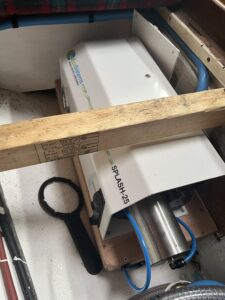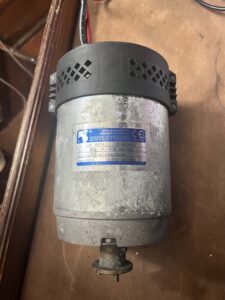A subtle change has come over boat life in Gran Canaria since the last time I was here.
Oh, the anchorage off Las Palmas beach is as full as ever – and just as rolly. But, amazingly, it still as cheap: Only €1.25 per night for a 32ft boat.
The thing that is noticeably different is what happens at the dinghy dock in the marina. Last time, the crews from the small boats – the ones on a budget – would arrive with the inevitable collection of 5-litre plastic water bottles, which they would fill one by one from the nearest marina tap.
Hardly anybody does that anymore. In fact, it was seeing a young French couple busy with the chore that made me realise how unusual it was – and what a change had come over the cruising scene.
Because I don’t do it either. As regular readers will know – I now have a watermaker (in fact, it was the interminable wait to get it that caused me to leave Falmouth so late… which in turn led to the knockdown… which is the reason I’m still here awaiting repairs and have leisure to analyse life at the dinghy dock.)
What has changed, of course, is that two years ago, watermakers were considered a luxury reserved for big boats – and, by definition, big budgets. But, when you think about it, they are no more expensive than a couple of new sails – and sails are considered essential.
But where are you going to put it on a small boat?
And how are you going to power it with only 220ah of lead-acid batteries?
But my friends Iain and Fiona on Ruffian of Amble wrote: “There is life before a watermaker, and there is life after a watermaker. If there is any way you can get one, you won’t regret it.”
Well, I’ve answered the first question in the previous post: A singlehander doesn’t need two 100-litre water tanks – not if he’s got a watermaker.
Then there’s the power – and this is something I have refined at anchor here over the past month. It was fine on the way down – believe me, there was no shortage of wind power beating down the Iberian coast this year. The difficulty arises when the generation business is left to the solar panels.
I have 80watts of fixed panel and 120 in a folding contraption the size of a briefcase when I can prop up on deck. That is enough on a December day in the Canary Islands.
The secret, surprisingly, is not because I have a small, low-energy watermaker but, instead, an Eco-Sistems Splash 25, which draws between 16 and 18amps and churns out 25litres an hour.
Because, you see, I only need to run it for 20 minutes a day. Twenty minutes at 25litres an hour is more than eight litres – and that’s all I need, even though I’ve forgotten all about being economical with the freshwater pump and fill the washing up bowl as if I were at home.
On a cloudy day (and yes, we do have them – it even rained yesterday), I set a timer for five minutes to remind myself to keep an eye on the voltage. Maybe I’ll switch off after 15 minutes and put in the other five after lunch.
“But isn’t this just laziness?” I hear you cry. “What’s wrong with filling cans?” Besides, most of the time, you can fill up alongside with a hose…
Of course you can – in Europe. But wait ‘til you get to the Caribbean: That was why I went in 2021 – to see if I needed things like a watermaker. And I found that Iain and Fiona were absolutely right. Not only does every island charge for it – whether out of a suspicious-looking hose on the dock or a pair of 40-gallon oil drums mounted on a sort of motorised raft (add a delivery charge). But when you get it, it’s actually rubbish.
Really! In three days, it smells of bad eggs, and you have to boil it – so now you’re using extra gas just to leave a glass of water in the kettle.
And one other thing to remember when you install your watermaker: The pump has to be below the level of the high-pressure unit. In a small boat, that means in the bilges.
And what do you find in small boat bilges but seawater? So put the pump on a plinth to keep it dry – and if it should get swamped, do not, under any circumstances, turn it on “to see if it still works”.
I know this from experience.
Instead, remove it and soak it in a bucket of fresh water for 24 hours – changing the water at least twice – more if you can spare it. Every three hours, turn the motor by hand.
Shake the water out and let it dry in the sun – completely.
Reinstall and you should find it is none the worse for the experience. If it makes a screeching noise, you still have salt in the bearings. These can be replaced. But if you continue to run it, the added load will burn out the wiring, which will certainly mean a new pump (and possibly a new boat if you burn that down as well).
Now, if you’ll excuse me, I have water to make.
I don’t really need it. I just like making it.

The Splash 25 under the starboard berth where there used to be a 100-litre water tank.

The low-pressure pump after its soaking.
